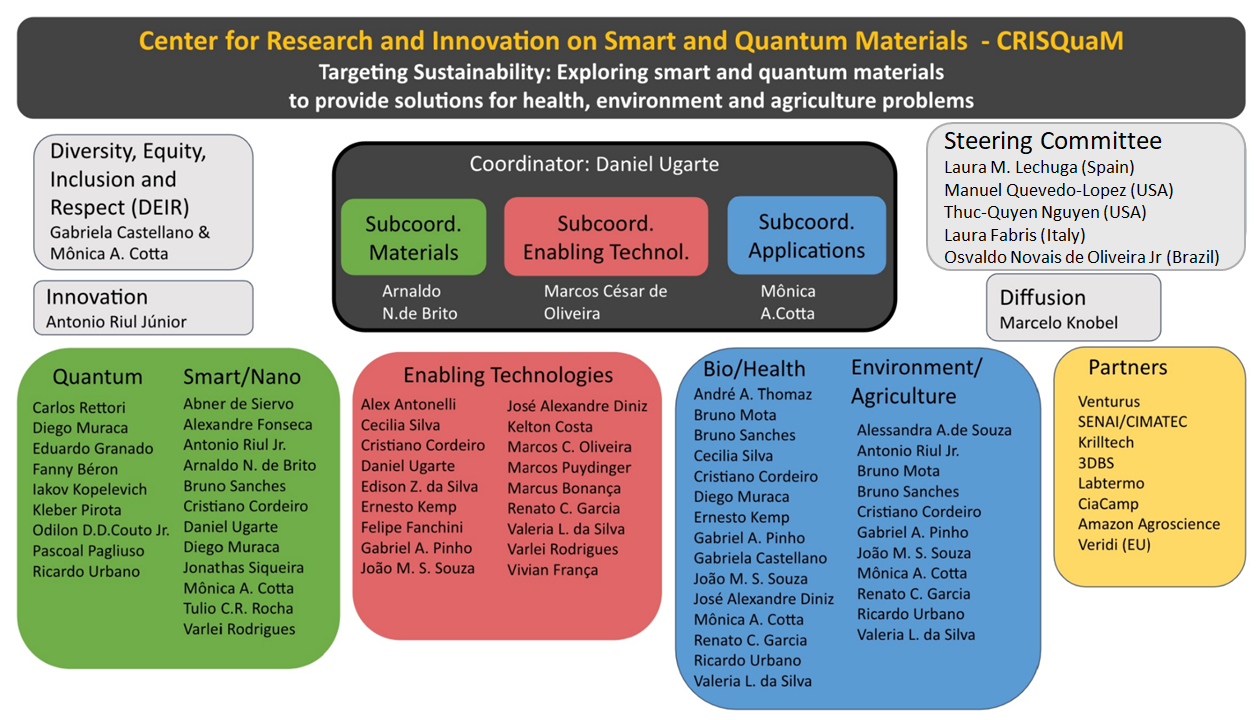BV-FAPESP: research projects supported in this Center
CRISQuaM in the Media: news about the center
CRISQuaM aims to explore the synergistic development of fundamental and applied science to create new materials with high potential for the construction of devices and sensors to address technological challenges related to sustainability, climate change, precision agriculture, ecology, and health. To achieve these goals, we have assembled an interdisciplinary and collaborative research team, integrating expertise across various scientific domains, researching novel materials with high innovation potential. By combining original synthesis methods, advanced characterization techniques, theoretical approaches, computational simulations, quantum technologies, and device construction designs, we aim to drive advances in smart and quantum materials, promoting scientific excellence and technological development. With this, we plan disruptive innovations in instrumentation—including hardware and AI-based tools—as well as in quantum technologies, biomedical devices, and signal processing, in addition to plant bionics, exploring plant-pathogen interactions. Besides research activities, we plan intensive actions in education, dissemination, and communication for the general public, as a modern society should be aware of the challenges humanity faces and how research and technology are essential for responsibly utilizing the planet's limited resources. CRISQuaM's Innovation activities are accelerated through partnerships with several companies in related technologies, many of them Brazilian. Finally, all activities of the Center are managed in accordance with diversity, equity, and inclusion goals and best practices.
The Center brings together scientists, engineers, and innovators in a collaborative effort to apply materials science and quantum technologies at the cutting edge, designing new materials and nano(bio)sensors for advanced diagnostics. The Center has a team capable of producing a wide range of (nano/micro) materials, along with precise chemical and physical characterizations using modern techniques (synchrotron, advanced microscopy, magnetotransport, magnetic resonance, optics, etc.). In addition, the team offers various options in enabling technologies, including miniaturization, processing, and additive manufacturing, as well as instrumentation, quantum sensing, and electronics development. Data analysis will employ updated approaches (numerical simulation, classical and quantum machine learning, and quantum optimization). Applications at the knowledge frontier will address urgent sustainability needs in environmental areas, precision agriculture, plant bionics, and biomedical interfaces, contributing to the development of local technologies in close partnership with the Brazilian industry.
The organization of the Center is based on three pillars — Materials, Enabling Technologies, and Applications — together with partner companies, as described in the figure below.

2025-08-27
Researchers found sauropod bones with signs of osteomyelitis, an infectious disease that can be caused by viruses, bacteria, fungi, or protozoa and that killed the animals quickly. The discovery suggests that favorable conditions for the disease existed in the region about 80 million years ago.
2025-08-27
Research involving more than 2,000 Brazilians reveals that while everyone’s performance is consistently lower in the morning, the afternoon shift only improves the performance of students with few or no symptoms of attention deficit hyperactivity disorder.
2025-08-27
The accumulation of these algae on beaches can harm health, tourism, fishing, and biodiversity. They are usually collected and disposed of in landfills, but a study by Brazilian researchers has found a use for the biomass: to produce lightweight ceramic clay aggregates.
2025-08-27
This neglected disease, also known as Peruvian wart and Oroya fever, is caused by bacteria of the genus Bartonella and is transmitted by sand flies. DNA found in insects from a protected area in Brazil is similar to that of pathogenic species found in Peru. While there is still no evidence that the new bacterium causes disease, scientists warn that monitoring should continue.
2025-08-27
Unpublished work organized by researchers from São Paulo State University and the University of São Paulo discusses the influence of fires on the ecological dynamics of nine large South American biomes.
2025-08-20
Research conducted on mice revealed that the COVID-19 virus uses cells responsible for testosterone production to replicate, thereby interfering with lipid metabolism. This helps explain the drop in testosterone and possibly cholesterol in patients with severe cases of the disease.
2025-08-20
Countries such as Colombia and Venezuela lead the way in terms of the extent of healthy soils, while regions such as the Brazilian Northeast, northern Mexico and parts of Chile and Argentina face the greatest challenges. The data can guide public policies for conservation.
2025-08-20
The compound is 100 times more effective than β-caryophyllene against the disease impacting orange groves in Florida and threatening citrus growers in the state of São Paulo, Brazil, the world’s largest orange producer.